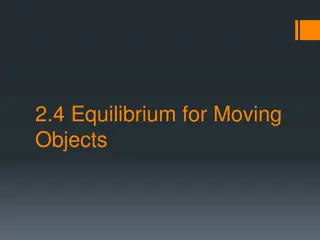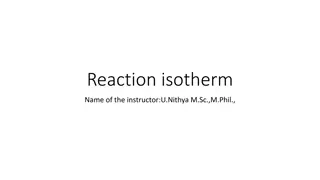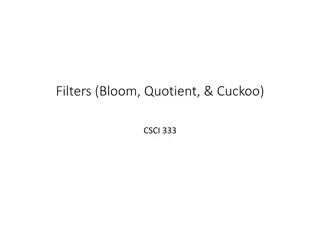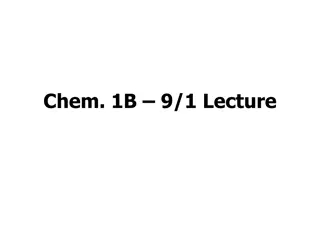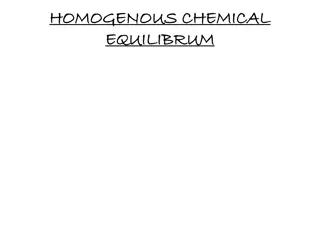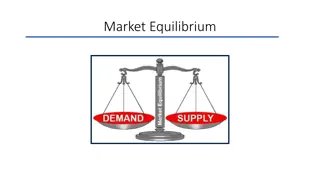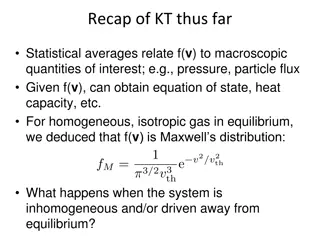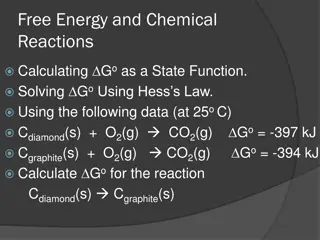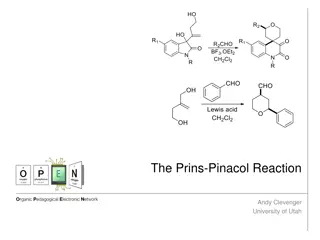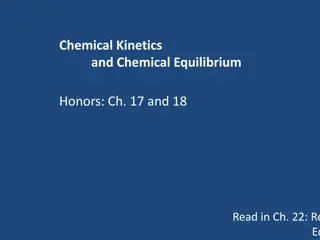Understanding Free Energy, Reaction Quotient, and Equilibrium Constant
This educational material delves into the concepts of free energy, reaction quotients, and equilibrium constants in chemical systems. It explains how to determine the direction of a reaction based on Q and K values, elucidates the role of Gibbs free energy in determining spontaneity, and provides calculations using standard thermodynamic data for various reactions. The content also covers the relationship between G, Go, and the equilibrium constant K, offering insights into predicting reaction favorability and equilibrium conditions in chemical processes.
Download Presentation

Please find below an Image/Link to download the presentation.
The content on the website is provided AS IS for your information and personal use only. It may not be sold, licensed, or shared on other websites without obtaining consent from the author. Download presentation by click this link. If you encounter any issues during the download, it is possible that the publisher has removed the file from their server.
E N D
Presentation Transcript
Section 19.3 Free Energy, the Reaction Quotient and the Equilibrium Constant Bill Vining SUNY College at Oneonta
Recall Q, K and Reaction Favorability The system is not at equilibrium. Reactants will be consumed, and product concentration will increase until Q = K. The reaction will proceed in the forward direction as written (reactants products). Q < K The system is at equilibrium, and no further change in reactant or product concentration will occur. Q = K The system is not at equilibrium. Products will be consumed, and reactant concentration will increase until Q = K. The reaction proceeds to the left as written (reactants products). Q > K
G, Go and Q Q represents the current state of the system. G determines if the reaction system in its current state is spontaneous in either direction. Go determines if the system is product-favored or reactant-favored. G < 0 G = 0 G > 0 Reaction is spontaneous in the forward direction (reactants products). Reaction is at equilibrium. Reaction is spontaneous in the reverse direction (reactants products). Go < 0 Go = 0 Go > 0 Reaction is product-favored. Reaction is neither reactant- or product-favored.. Reaction is reactant-favored.
Connecting G, Go and Q G = Go + RT lnQ Use standard thermodynamic data (linked) to calculate G at 298.15 K for the following reaction, assuming that all gases have a pressure of 16.91 mm Hg. Gfo (kJ/mol) 2NO(g) + O2(g) 2NO2(g) NO(g) 86.6 O2(g) 0 NO2(g) 51.3
Connecting G, Go and Q G = Go + RT lnQ Use standard thermodynamic data (linked) to calculate G at 298.15 K for the following reaction, assuming that all gases have a pressure of 16.91 mm Hg. Gfo (kJ/mol) 2NO(g) + O2(g) 2NO2(g) NO(g) 86.6 O2(g) 0 NO2(g) 51.3
G, Go and the Equilibrium Constant, K At equilibrium, G = 0 so 0 = Go + RT ln Q o o G RT G RT Go = RT ln Q = ln K and = K e Gfo (kJ/mol) Use standard thermodynamic data to calculate K at 298.15 K for the following reaction. NO(g) 86.6 O2(g) 0 NO2(g) 51.3 2NO(g) + O2(g) 2NO2(g) Go = -70.6 kJ
G, Go and the Equilibrium Constant, K A student determines the value of the equilibrium constant to be 1.11E6 for the following reaction. o G RT o G RT = ln K = K e 3Fe2O3(s) + H2(g) ===== 2Fe3O4(s) + H2O(g) Based on this value of Keq: G for this reaction is expected to be (greater, less) than zero. Calculate G and the free energy change for the reaction of 1.67 moles of Fe2O3(s) at standard conditions at 298K.
G, Go, Q, and K Can a chemical system have a positive value of Go and yet still be favored to react in the forward direction?


